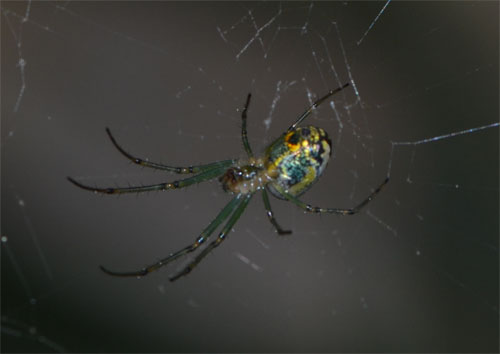
Orb weaver (likely Basilica orbweaver) on its web, June 9 2013

Orb weaver (likely Basilica orbweaver) on its web, June 9 2013
Posted in Fauna, Interesting | Leave a Comment »
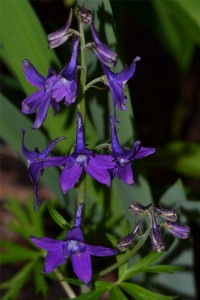
Delphinium tricorne displaying its velvety blue flowers April 28 2013
Now, a month later, I find these lost shots on my camera. Before giving in to the reflex to wipe the memory card, I take another peek at the plant month that was. The pictures did not all turn out perfect – many suffer from an unsteady hand or low light conditions, but I did select a few to give you a sampling of the flowers and shapes you could add to your woodland garden. Hope you enjoy them as much as I did.
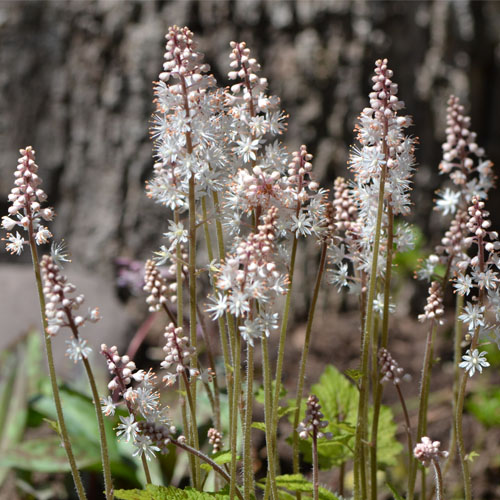
Foamflower (Tiarella cordifolia) in full bloom April 28 2013
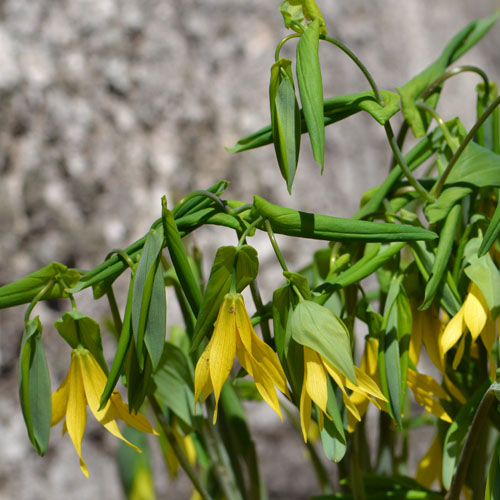
The large bellwort is simply spectacular against a still barren woodland. The leaves remain as a beautiful groundcover long after the flowers are gone
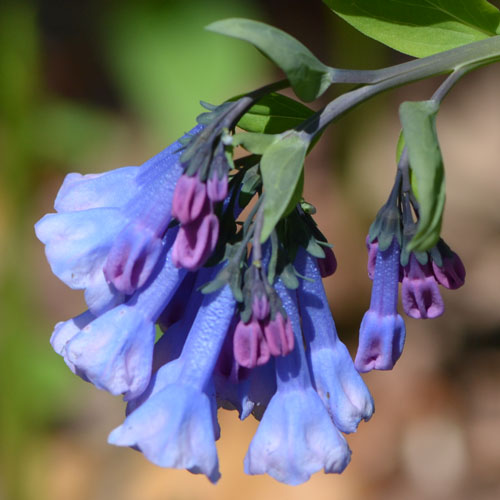
Virginia bluebells bring the best spring blue ever. (April 28 2013)
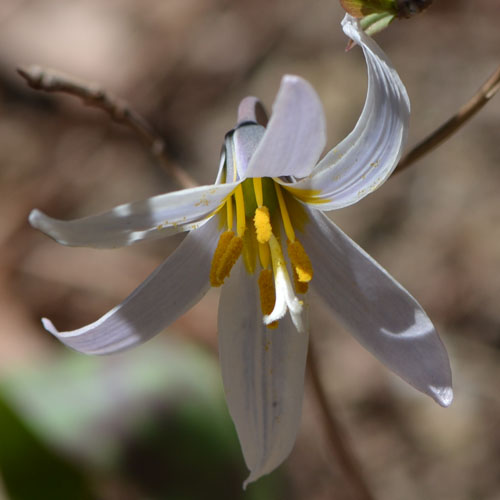
The white trout lily is barely a few inches tall, but it makes up for size with this beautiful display
Posted in Flora, Interesting | 2 Comments »
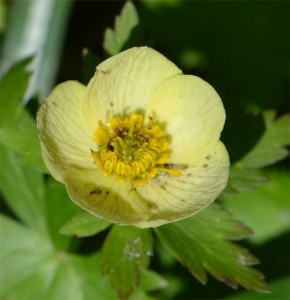 The american globeflowers in my garden ceased blooming a week or two ago, but just now I’ve had a chance to put pen to paper. I find the distribution of this plant quite curious – there is a distinct western population, and a population in a few eastern states (New York, Connecticut, Pennsylvania, New Jersey, and Ohio). Some sources tell of these being distinct sub species, but if that is the case, where is the plant that ties them across the continent? Does the distribution have something to do with the last glaciation period (Trollius laxus prefers soils derived from glacial materials)? If that is the case, then the Cape Cod woodland garden should be a good spot, even though the plant is not native here. In the wild this plant is pretty rare: Jones (2001) states that there are approximately 40 known occurrences of this species in eastern North America. Most of these occurrences have less than 100 individuals, and almost all have less than 1000 individuals.
The american globeflowers in my garden ceased blooming a week or two ago, but just now I’ve had a chance to put pen to paper. I find the distribution of this plant quite curious – there is a distinct western population, and a population in a few eastern states (New York, Connecticut, Pennsylvania, New Jersey, and Ohio). Some sources tell of these being distinct sub species, but if that is the case, where is the plant that ties them across the continent? Does the distribution have something to do with the last glaciation period (Trollius laxus prefers soils derived from glacial materials)? If that is the case, then the Cape Cod woodland garden should be a good spot, even though the plant is not native here. In the wild this plant is pretty rare: Jones (2001) states that there are approximately 40 known occurrences of this species in eastern North America. Most of these occurrences have less than 100 individuals, and almost all have less than 1000 individuals.
Trollius laxus prefers wet woods and meadows, and can survive in deep shade. It will need sunlight to produce flowers and seed. The plant can also grow small colonies from rhizomes.
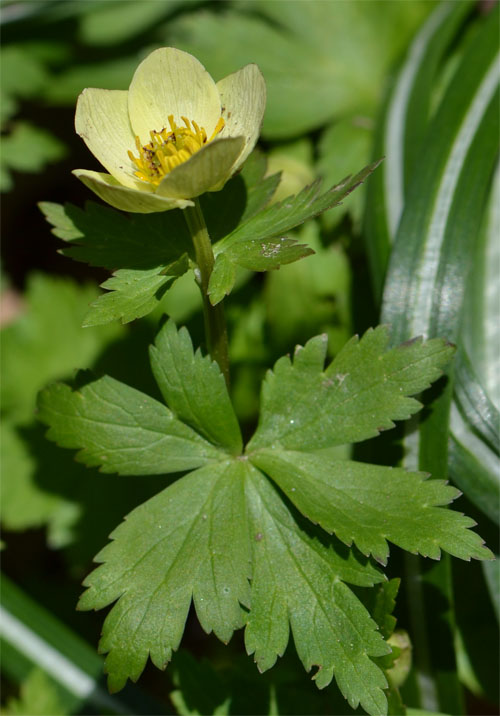
Posted in Flora, Plant bio | Leave a Comment »
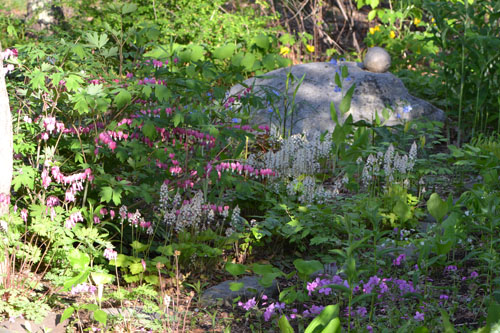
The strip of land next to the driveway is one of my favorite spots. In what amounts to a 80 square foot area, I’ve managed to grow some 50 native plants, and most of them seem to get along well. Sure, some are more aggressive than others, but I figure with a bit of human intervention I can assure some diversity. My role in this location has changed from active planter to manager. When we inherited this plot of land it was quite barren. Some sad looking Pachysandra terminalis (originating from Japan, but widely used as a groundcover everywhere) and assorted weeds were part of the original scene. I initially added some non-natives such as the hostas and Lamprocapnos spectabilis (old fashioned bleeding heart), but I’ve changed the look and feel much more dramatically by getting rid of the Pachysandra terminalis altogether, and adding natives. I have creeping phlox, foamflower, fringed bleeding heart, baneberry, canada anemone, wild ginger, shooting stars, lobelias, beebalm, woodland sunflowers, white turtleheads, wood poppy (extremely prolific!), twinleaf, virginia bluebell, spiderworts, solomon’s seal, bellworts, 3 or 4 kinds of asters and at least 4 species of ferns. I have forgotten what’s where, which often brings a nice surprise to the eye. While not all plants are currently blooming (some are past prime already but many still have to erupt in color), there is something new to behold every other day. Variety is the spice of life, is it not?
Posted in Flora, Interesting | Leave a Comment »
Yellow fairybells is another interesting native neighbor (meaning it does not occur naturally in Massachusetts – it is found in Appalachia, Arkansas and the province of Ontario). This member of the Lily family displays strongly veined light green leaves – it is somewhat similar to Uvularia grandiflora from afar. The little yellow flowers are beautiful, but like Uvularia sp. the bell shaped flowers are obscured by the leaves. The orange to red berries are much more noticable, but those appear later in the summer. The berries are eaten by birds and small mammals. They can be eaten by people in small quantities. Yellow fairybells does well in moist, acid to neutral soils in shade to partial shade, so it’s a natural for the Cape Cod woodland garden. Over time it will easily establish dense colonies. This is a good companion plant to Phlox divaricata (woodland phlox) and Tiarella cordifolia (foamflower).
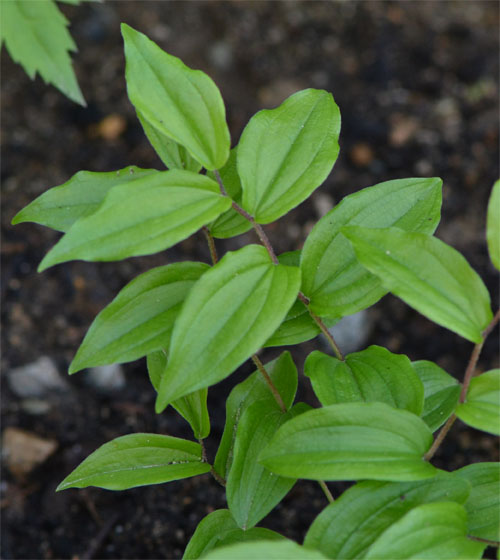
| Scientific name: | Prosartes languinosa |
| Common name: | yellow fairybells |
| Other name: | yellow mandarin |
| Bloom time: | mid spring, early summer |
| Color: | greenish yellow |
| Light requirements: | shade to partial shade |
| Zone: | 3 to 8 |
| Soil: | acidic to neutral |
| Water: | average water needs |
| Origin: | eastern North America, not New England |
Posted in Flora, Plant bio | Leave a Comment »
I have to admit, I am not quite sure whether this is now truly considered a distinct species, or a sub species from Athyrium filix-femina (lady fern). Whatever the case, I added the “forma rubellum” to my yard. This fern can be grown quite easily on rich woodland soils, although it does not like wet feet or windy conditions. The light green fronds are attached to red stems (or “stipes” to use the correct botanical term). The effect is stunning. Northern lady fern will form dense colonies, as new growth sprouts from rather short rhizomes. In comparison, ostrich fern is putting out new growth one or even two feet away from the original plant, leaving plenty of space in between. I have an area where I mixed different ferns: Ostrich ferns provide the stately height and structure, christmas ferns provide year round foliage, and the northern lady ferns will add the accents of red and sunlight bouncing off light green fronds. Ferns take their time to emerge from the soil, so I have trout lilly and virginia bluebells among the ferns to provide color in April and early May.
You will see cultivars of this plant in garden centers, as it is a fern that readily adapts to new surroundings (provided you have the right soil conditions)
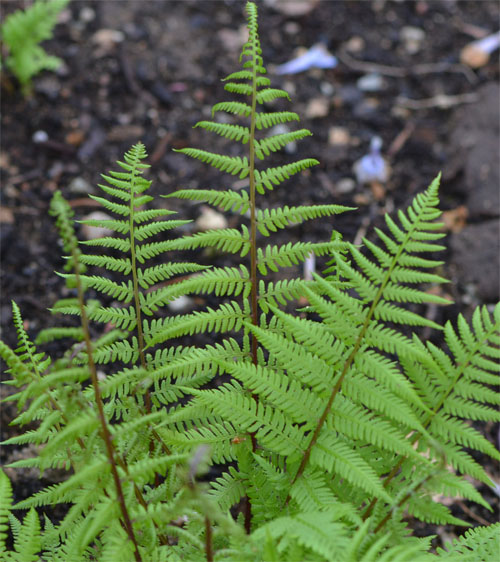
Posted in Flora, Interesting, Plant bio | Leave a Comment »
While Phlox divaricata is not native to Cape Cod, or even Massachusetts, this “native neighbor” is just too beautiful a plant to leave out of our woodland garden. Wild blue phlox, or woodland phlox as it is often called, is found from Hudson Bay all the way down to Texas and Florida. For some reason New England was left out of its range. Like creeping phlox (phlox stolonifera), the plant likes part shade to full shade and rich organic soils. Your woodland garden should be the perfect spot.
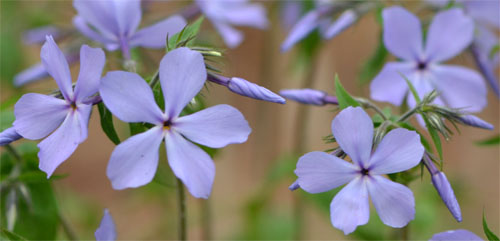
Woodland phlox with decidedly blue overtones – May 9 2013
Like creeping phlox, it spreads and forms dense mats over time. The foliage is a lighter green and the stems reach a few inches higher than Phlox stolonifera. Woodland phlox has fertile and infertile shoots. The latter do not produce any flowers and the stems are somewhat shorter and the leaves have rounded tips. The fertile shoots produce flowers that range from pink to blue. The flowering fertile shoots die down after seeds have been produced, but the infertile shoots remain green for the remainder of the growing season. Compared to creeping phlox, the leaves are softer, and more attractive to herbivores. Rabbits in particular may enjoy this phlox offering.
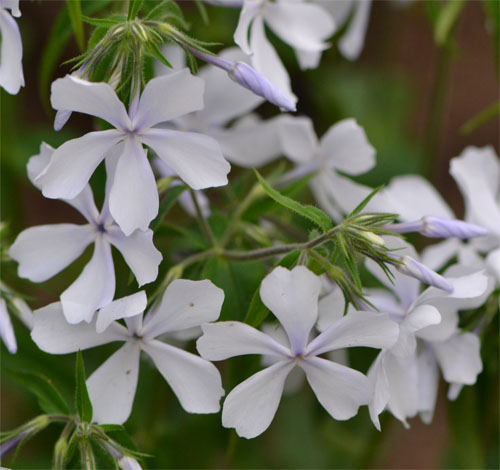
This batch of woodland phlox is showing flowers that are more white than blue – May 9 2013
This plant has many cultivars that are available at most garden stores.
P. stolonifera or P. divaricata?
If you have the room in your woodland garden, plant both. Phlox stolonifera’s color range usually covers the pinks, while Phlox divaricate is definitely more widespread in the blue spectrum. P. stolonifera tends to keep a lower profile while P. divaricate brings a more “bushy” appearance. Both species have flowers with 5 lobes, but P. divaricata’s lobes are much deeper cut.
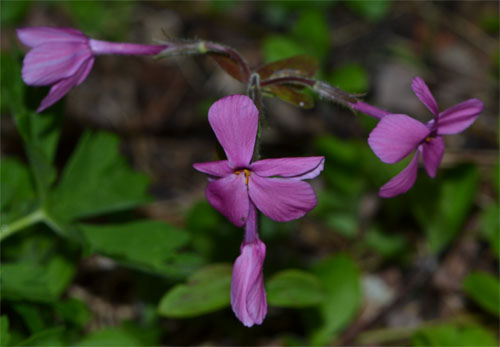
This creeping phlox is just unveiling its flowers. Unlike wild blue phlox, the foliage remains close to the ground, and the flowers emerge on elevated stems
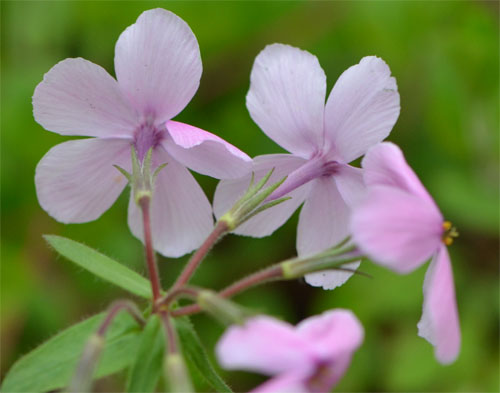
Notice the pink hues and the flower petals that are not as deeply cut as Phlox divaricata
| Scientific name: | Phlox divaricata |
| Common name: | wild blue phlox |
| Other name: | woodland phlox |
| Bloom time: | mid spring, early summer |
| Color: | blue, violet, lavender |
| Light requirements: | sun to partial shade, light shade |
| Zone: | 3 to 8 |
| Soil: | acidic to neutral |
| Water: | average water needs |
| Origin: | eastern North America, not New England |
Posted in Flora, Plant bio | Leave a Comment »
Nodding mandarin is another interesting native neighbor (meaning it does not occur naturally in Massachusetts – it is found in a few eastern states from Michigan down to Georgia). This member of the Lily family displays strongly veined light green leaves – it is somewhat similar to Uvularia grandiflora from afar. The flowers are beautiful, mostly white with purple spots and streaks, but like Uvularia sp. the bell shaped flowers are obscured by the leaves. The straw colored fruit isn’t much more noticable, but those appear later in the summer. Nodding mandarin does well in moist, acid to neutral soils in shade to partial shade, so it’s a natural for the Cape Cod woodland garden. Over time it will establish new growth on rhizomes. The colonies are not as dense as Prosarta languinosum (yellow fairybells).
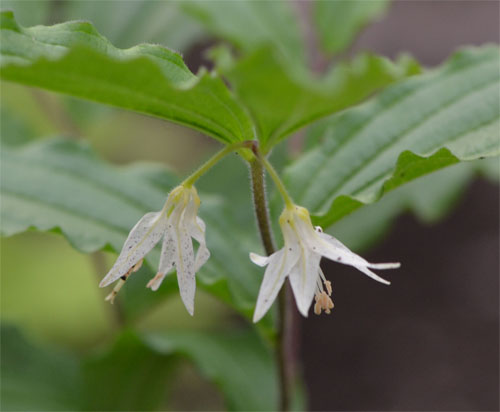
| Scientific name: | Prosartes maculata |
| Common name: | nodding mandarin |
| Other name: | formerly known as Disporum maculatum |
| Bloom time: | mid spring, early summer |
| Color: | white with purple streaking |
| Light requirements: | shade to partial shade |
| Zone: | 3 to 8 |
| Soil: | acidic to neutral |
| Water: | average water needs |
| Origin: | limited distribution in eastern North America, not New England |
Posted in Edible, Flora, Plant bio | Leave a Comment »
It is an incredible testament to nature these past few weeks that the group of wasps living outside my kitchen window has returned to the exact same spot they have nested at ever since we moved to this house. Last fall we waited until the last of the plants and insects were done thriving and got our house washed and painted. The house painters use all manner of chemicals – although supposedly we got the most chem free house wash one can get (which I was told would not hurt plants). Even with this power wash and a complete eradication of any vestiges of wasp-nest, the wasps have returned to build one in the same spot. Their powerful sense of smell has led them back to this spot.
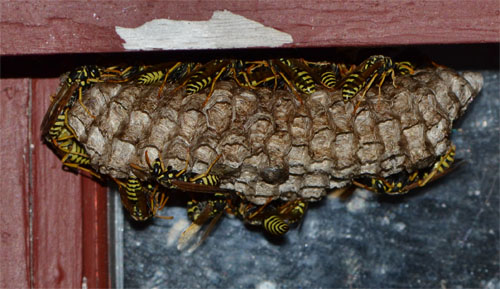
Animals return or make their debut
It has been unseasonably cold – or at least colder than the last few springs – so many of the shade plants and most of the oak trees have yet to bloom. Also, we haven’t seen any butterflies or hummingbirds yet. However, the bird-feeder visits in general are constant right now – and this week I saw my first American goldfinch at our feeder (common but not something I’d seen in our yard before). After our owl visit this February, G bought an “owl house” and we are thrilled that an actual owl has moved into it – “who” knows if it’s the same one. Not sure we’ll try a picture, as it’s not nice to startle them. Adding to the check list of new visitors: G did his best Sesame Street “The Count” imitation with a bat behind the house one night, I think he thought he was in Costa Rica for a moment. And I finally discovered what is using a huge hole in our yard – we have a resident groundhog.
It will be interesting to see what other fauna we find in our yard this spring and summer. With just a few more critters I think I can start charging admission.
Posted in Fauna, Flora, Guest blogger | Leave a Comment »
Last weekend I took a stroll along my favorite fishing beach to see whether the striped bass had come in yet (affirmative, but I did not get any keepers). On the way there I returned to the waves a couple of live male horseshoe crabs, some 20 spider crabs, and a mantis shrimp. This was a first for me. I’ve seen documentaries on the species, but always assumed they lived in exotic locales. Finding one, alive, washed up on a Cape Cod beach was exciting. The animal was some 10 inches long, pale and transparent in places, and had its claws retracted. I made sure to pick it up away from the impact zone, instinctively. That was probably a good move, since they seem to be aggressive little predators. I read somewhere on the internet that a Bahamian variety is locally known as a “toe-popper,” since it will split the toe of any careless wader wide open.
Cape Cod is probably the northern most range for the mantis shrimp, but apparently they have been found before – There is a nice post and pictures on Churbuck.com about the animal: http://www.churbuck.com/wordpress/2008/11/critter-from-the-bay-mantis-shrimp/
Apparently these animals are edible, but I would prefer not to see it perched on my shrimp cocktail glass…
Posted in Fauna, Interesting | Leave a Comment »